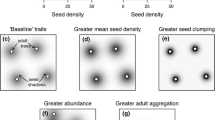Summary
The prevalence of statistical clumping in natural populations can sometimes obscure mutual avoidance behavior and the adaptive role of spacing out among population members. The problem is particularly severe in rare species where the inverse square relationship between expected nearest neighbor distance and population density demands mean distances between individuals be excessively large to maintain randomness or overdispersion. Realistically, individuals dispersing from a central nucleus might be expected to establish a minimum distance from neighbors to obtain a substantial gain in fitness but further dispersal would be undesirable due to increasing costs and decreasing gains. The result would be higher clumping at low densities. Data on clumping of rare species in an oak-cynipid gall wasp complex are interpreted in the context of the minimum distance notion, and the influence of parasitism on cynipid host population dispersion is discussed.
Similar content being viewed by others
References
Clark PJ, Evans FC (1954) Distance to nearest neighbor as a measure of spatial relationships in populations. Ecology 35:445–453
Cottam G (1955) Correction for various exclusion angles in the random pairs method. Ecology 36:767
Greig-Smith P (1964) Quantitative plant ecology (2nd ed.) Butter-worths, London
Kershaw KA (1964) Quantitative and dynamic ecology. Elsevier, New York
Mueller-Dombois D, Ellenberg H (1974) Aims and methods of vegetation ecology, Wiley, New York pp 547
Simberloff D (1979) Nearest neighbor assessments of spatial configurations circles rather than points. Ecology 60:679–685
Southwood TRE (1975) Ecological Methods (2nd ed) Chapman and Hall Ltd, London
Washburn JO, Cornell HV (1979) Chalcid parasitoid attack on a gall wasp population on oak (Acraspis hirta) Bassett, on Quercus prinus, Fagaceae). Canadian Ent 111:391–400
Author information
Authors and Affiliations
Rights and permissions
About this article
Cite this article
Cornell, H.V. The notion of minimum distance or why rare species are clumped. Oecologia 52, 278–280 (1982). https://doi.org/10.1007/BF00363850
Received:
Issue Date:
DOI: https://doi.org/10.1007/BF00363850




